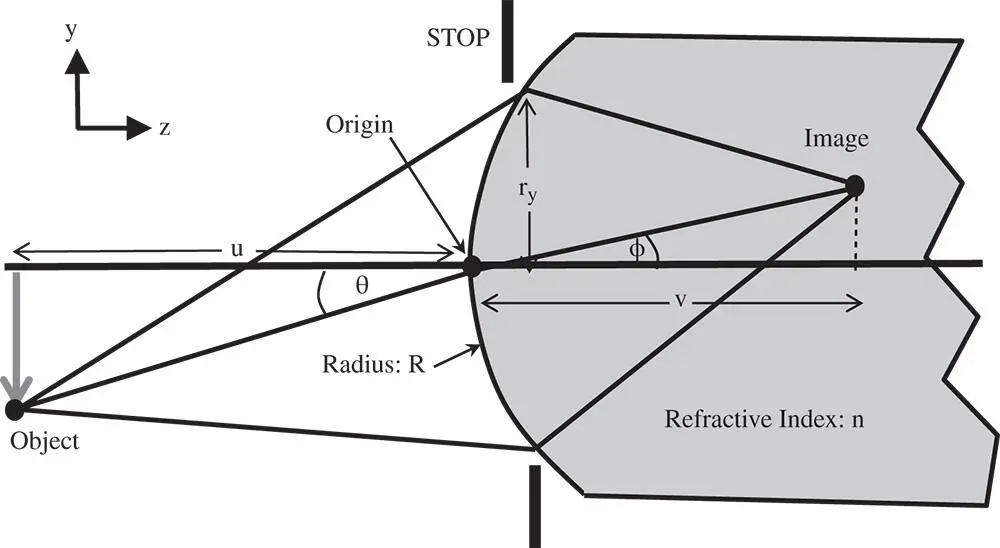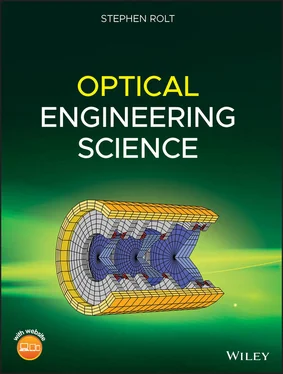The treatment of aberrations, thus far, has been entirely generic. We have introduced the five Gauss-Seidel aberrations without specific reference to how they are generated at specific optical surfaces and by individual optical components. This will be discussed in detail in the next chapter. The most important feature of this treatment is that the third order aberrations are additive through a system when described in terms of OPD. That is to say, the five aberrations may be calculated independently at each optical surface and summed over the entire optical system. This analysis is an extremely powerful tool for characterisation of aberration in a complex system.
1 Born, M. and Wolf, E. (1999). Principles of Optics, 7e. Cambridge: Cambridge University Press. ISBN: 0-521-642221.
2 Hecht, E. (2017). Optics, 5e. Harlow: Pearson Education. ISBN: 978-0-1339-7722-6.
3 Kidger, M.J. (2001). Fundamental Optical Design. Bellingham: SPIE. ISBN: 0-81943915-0.
4 Kidger, M.J. (2004). Intermediate Optical Design. Bellingham: SPIE. ISBN: 978-0-8194-5217-7.
5 Longhurst, R.S. (1973). Geometrical and Physical Optics, 3e. London: Longmans. ISBN: 0-582-44099-8.
6 Mahajan, V.N. (1991). Aberration Theory Made Simple. Bellingham: SPIE. ISBN: 0-819-40536-1.
7 Mahajan, V.N. (1998). Optical Imaging and Aberrations: Part I. Ray Geometrical Optics. Bellingham: SPIE. ISBN: 0-8194-2515-X.
8 Mahajan, V.N. (2001). Optical Imaging and Aberrations: Part II. Wave Diffraction Optics. Bellingham: SPIE. ISBN: 0-8194-4135-X.
9 Slyusarev, G.G. (1984). Aberration and Optical Design Theory. Boca Raton: CRC Press. ISBN: 978-0852743577.
10 Smith, F.G. and Thompson, J.H. (1989). Optics, 2e. New York: Wiley. ISBN: 0-471-91538-1.
4 Aberration Theory and Chromatic Aberration
4.1 General Points
In the previous chapter, we developed a generalised description of third order aberration, introducing the five Gauss-Seidel aberrations. The motivation for this is to give the reader a fundamental understanding and a feel for the underlying principles. At the same time, it is fully appreciated that optical system design and detailed analysis of aberrations is underpinned by powerful optical software tools. Nevertheless, a grasp of the underlying principles, including an appreciation of the form of ray fans and optical path difference (OPD) fans, greatly facilitates the application of these sophisticated tools.
The treatment presented here is restricted to consideration of third order aberrations. Before the advent of powerful software analysis tools, the designer was compelled to resort to a much more elaborate and complex analysis, in particular introducing an analytical treatment of higher order aberrations. For all the labour that this would involve, the reader would gain little in terms of a useful understanding that could be applied to current design tools. As the third order aberrations are third order in transverse aberration and fourth order in OPD, so succeeding higher order aberrations are fifth, seventh etc. order in transverse aberration, but sixth, eighth order in OPD. That is to say, aberrations, whose order is expressed conventionally in terms of the transverse aberration, can only be odd. One can re-iterate the analysis of Section 3.4to generate the form and number of terms involved in the higher order aberrations. This is left to the reader, but it is straightforward to derive the number of distinct terms N nas a function of aberration order, n :
(4.1) 
In concentrating on third order aberrations, we shall, in the remainder of this chapter, seek to determine the impact of refractive surfaces, mirrors, and lenses on all the Gauss-Seidel aberrations. This analysis will proceed, initially, on the assumption that the surface in question lies at the pupil position. Subsequently, the impact of changing the position of the stop will be analysed. Manipulation of the stop position is an important variable in the optimisation of an optical design. The concept of the aplanatic geometrywill be introduced where specific, simple optical geometries may be devised that are wholly free from either spherical aberration (SA) or coma (CO). These aplanatic building blocks feature in many practical designs and are significant because, in many instruments, such as telescopes and microscopes, there is a tendency for spherical aberration and coma to dominate the other aberrations. The elimination of spherical aberration and coma is thus a priority. Furthermore, by the same token, astigmatism (AS) and field curvature (FC) are more difficult to control. In particular, the control of field curvature is fundamentally limited by Petzval curvature, as alluded to in the previous chapter.

Figure 4.1 Calculation of OPD for refractive surface.
4.2 Aberration Due to a Single Refractive Surface
The analysis of the aberrations of a single refractive surface is based on the computation of the OPD of a generalised field point to the appropriate order (4th) in terms of field angle, θ and ray height, r , at the pupil. For this analysis, we will assume that the pupil is located at the lens surface. In calculating the OPD, we force all rays to go to the paraxial focus and compute the OPD with respect to the chief. Figure 4.1shows an object with a field angle, θ, located at a distance, u from a sphericalrefractive surface of radius R . It must be emphasised, in this instance, that this analysis applies specifically to a spherical surface. In this geometry, it is assumed that the object is displaced from the optical axis in the y direction. The paraxial image is itself located at a distance v from the surface and the position of a ray at the surface (and stop) is described by its components in x and y – h xand h y.
The image in this case is the paraxial image and from the paraxial theory, the angle φ may be expressed in terms of θ as θ/ n . To compute the optical path of a general ray as it passes from object to paraxial image, we need to define the ray co-ordinates at three points:



The z co-ordinate of the stop position is derived from the binomial expansion for the axial sag of a sphere including terms up to the fourth power. In making this approximation, it is assumed that h is significantly less than R. If we were to adopt the paraxial approximation we would only consider the first r 2term in the expansion. In the case of third order aberration, we need to consider the next term. It is then very straightforward to calculate the total optical path, Φ, for a general ray in passing from object to paraxial image:
(4.2) 
Читать дальше

















